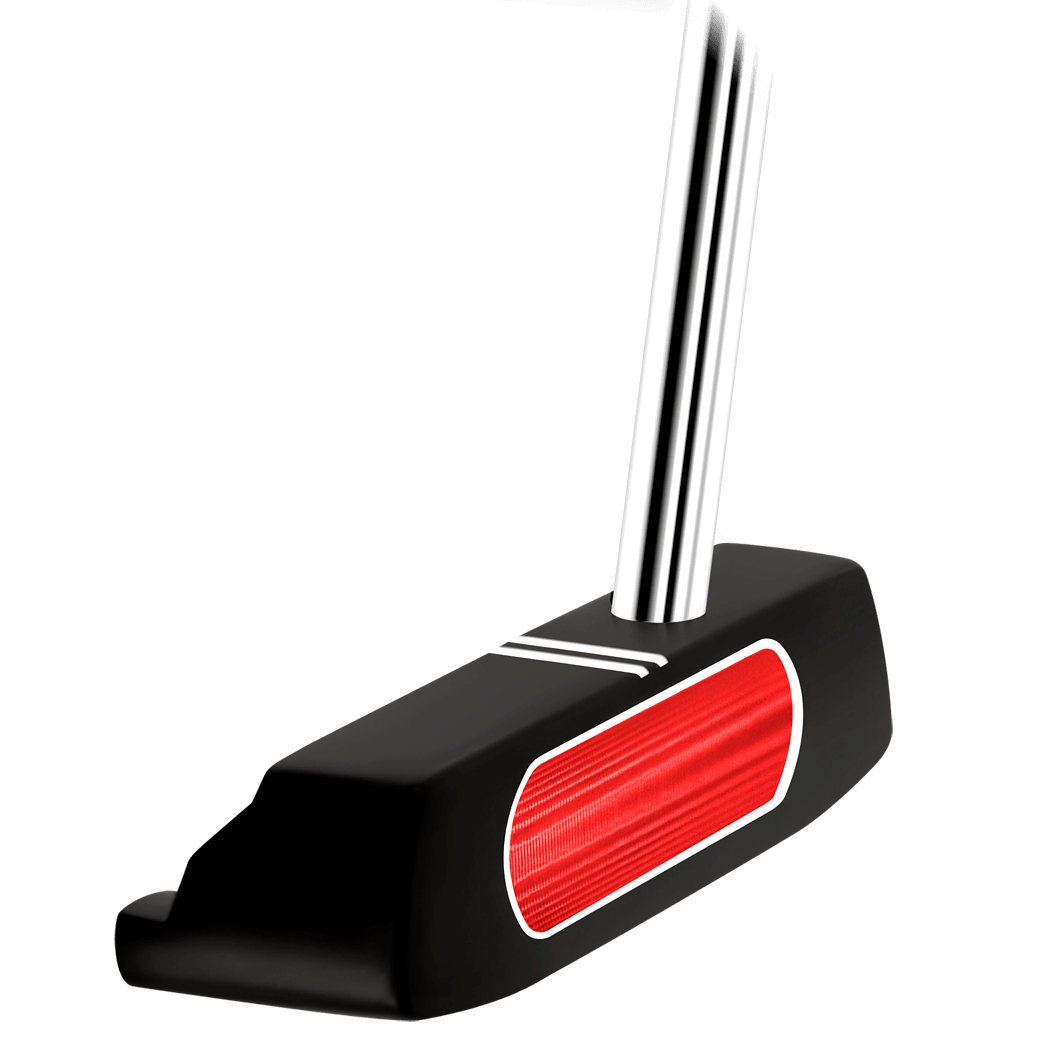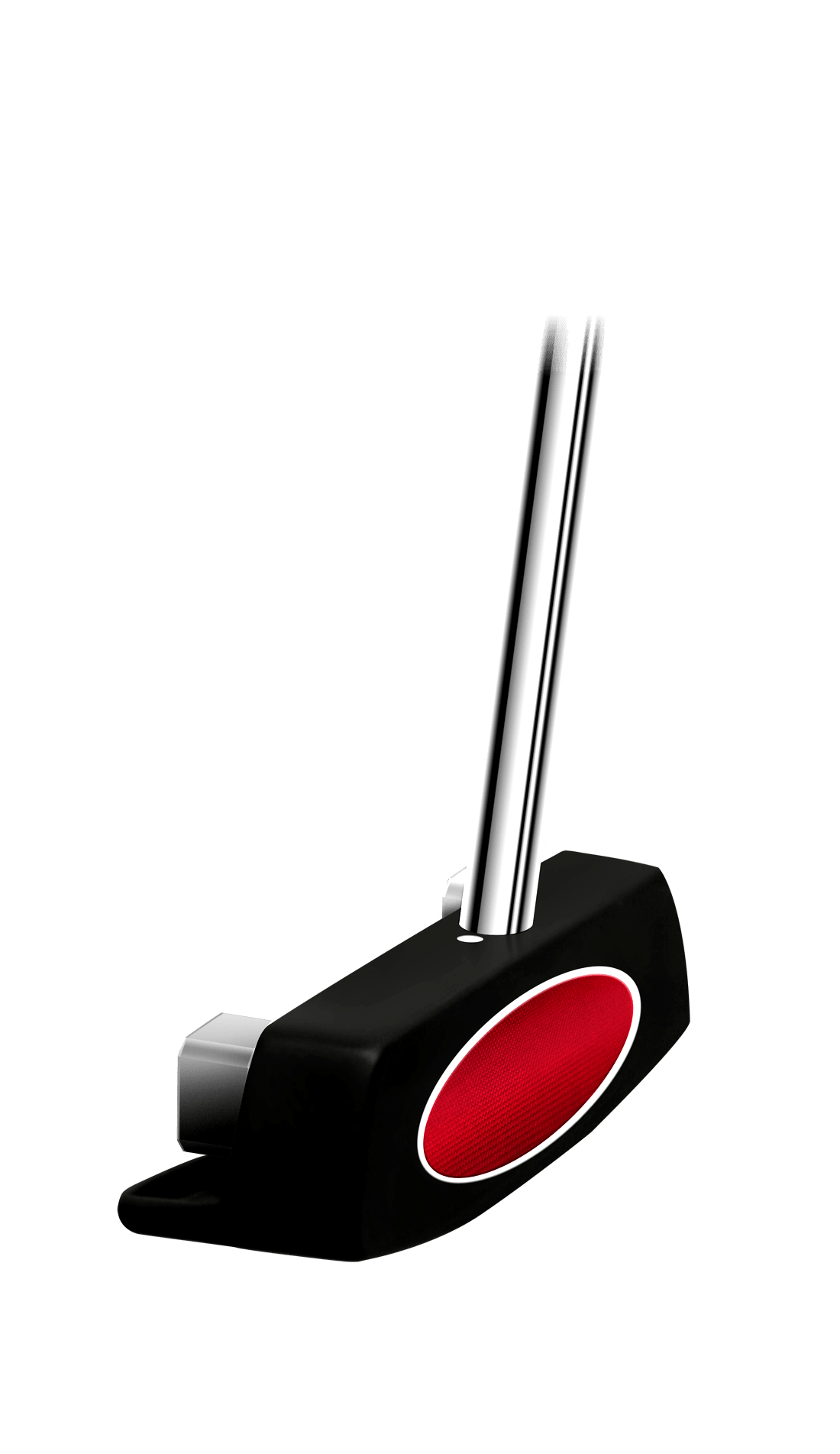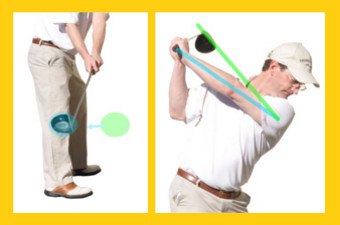
So you've heard someone's golf swing described as being “flat” and wondered exactly what the term means. Does his swing lack energy or power? Does it cause a lot of shots along the ground?
Well, no. “Flat” describes a swing plane that is more horizontal than the norm. For a right-handed player, this means the left arm forms an angle of less than 45° with the ground at the top of the backswing. PGA Tour standout Matt Kuchar is an extreme example of a golfer whose swing is flat.
The opposite of a flat swing is an “upright” swing, or one that's more vertical than normal. Jack Nicklaus and Fred Couples are two greats with upright swings.
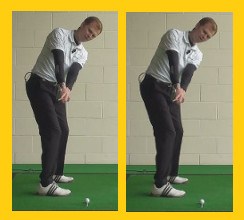
Golfers with flat swings tend to hit shots which bend from right to left (draws or hooks). Flat swingers employ a more rotational action back and through the ball as well. Players who stand very upright or close to the ball tend to swing on a flat plane, though this isn't always the case.
Having a flat swing isn't necessarily bad or good, but it helps explain why some golfers – possibly including you -- hit the ball the way they do.
Lip-out: When a shot (usually a putt) hits the rim of the cup and does not drop into the hole, it's called a Lip-out.
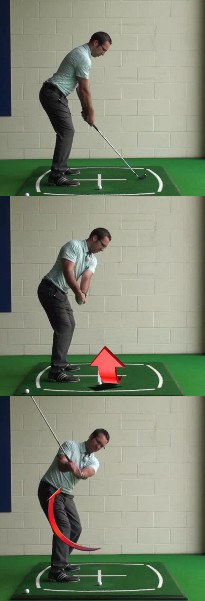
What is a Flat Golf Swing?
One of the great things about golf is the many different ways that you can choose to swing the club. There is no one 'right way' to swing, which means that each player on the course has a slightly different method that they use to hit shots. Sure, there are common traits that are seen between players, but everyone has something unique within their mechanics. It is the job of each golfer to uncover the style of swing that will allow them to reach their potential on the course.
As you are searching for your own swing, it is important to consider what kind of plane you want to use in order to deliver the club to the ball. In golf, 'plane' refers to the angle of the club during the backswing and downswing. A swing with a steep plane is one that has the club go high up into the air on the backswing, while a flat plane keeps the club lower to the ground, with the hands near to the right shoulder at the top (for a right handed golfer). In the content below, we are going to look at the advantages and disadvantages of using a flat plane in your golf game.
Of course, assuming you already play golf, you already have a swing plane of some kind picked out for your swing – whether you know it or not. Swing plane is one of the things within the golf swing that is actually very consistent, so yours probably doesn't change much from shot to shot even if you are a beginner. So, the question becomes whether or not you should make a change to a flat swing plane (or if you should keep your flat plane, if that is what you are currently using). Making any kind of swing change is difficult, so you should only switch to a flatter swing if you are confident that there will be rewards at the end of the process.
This is the kind of decision that you should weigh before rushing into action. Many golfers decide to make changes to their swings just out of simple frustration, as they are tired of making the same mistakes over and over again. While that frustration is understandable, you aren't going to get any better by making rash decisions about your technique. Carefully read and understand the content below regarding flat swings, and then decide if this is a method that could help you find improvement on the course. There are plenty of good golfers at the professional level that use a flat swing – but there are just as many, if not more, who use upright swings. As was mentioned above, there is no right or wrong answer on this issue – but there is a choice that will work best for you. Educate yourself on the ins and outs of a flat golf swing and proceed in the manner that you feel is best.
All of the content below is based on a right handed golfer. If you happen to play left handed, please take a moment to reverse the directions as necessary.

Identifying a Flat Swing
The first step in this process is understanding what it is exactly that makes up a flat swing. This is where it can come in handy to watch some golf on TV from time to time. If you are able to catch a few tournaments in order to watch the best players in the world, you will have an opportunity to spot various techniques that they use to move the club around their bodies. Some will swing the club flatter, while others will put it well up into the air. The more you watch golf on TV, the more you will understand about the golf swing and how you might be able to improve your own technique.
Before you are able to spot players using a flat swing plane in professional tournaments, you will first need to know what you are looking for in this type of swing. The following three points are all good signs that the player has a golf swing which would fall into the 'flat' category.
- Left arm below shoulder plane. At the top of the backswing, a flat golf swing will have the left arm below the plane of the shoulders. That means, when viewed from behind, the right shoulder will be visible at the top of the golf swing, where it might not be visible in a steeper swing. This is one of the quickest ways to determine whether or not you are looking at a flat golf swing. Can you see the players right shoulder at the top of the swing? If so, and the left arm is below the position of that shoulder, you can be confident that the swing would fit nicely into the flat category. However, if the right shoulder is obscured by the left arm at the top, or if that left arm is higher than the position of the right shoulder, you will know you are looking at a swing that would be considered neutral or steep.
- Big shoulder turn. Players who use a flat golf swing tend to make a bigger shoulder turn than those using a steeper plane. It is necessary to pair a flat plane with a big shoulder turn in order to get satisfactory results, so watch how far back a player turns to help determine what kind of swing they are using. Of course, players with steep swing planes can use big shoulder turns as well, but often those rotations fall somewhat short of what would be seen in a flatter plane. The flat golf swing is one that is driven by shoulder rotation – on the other hand, a steeper swing is focused on the motion of the arms, while the shoulder turn is something of a secondary consideration.
- Flat or bowed left wrist. The final point you need to watch for when spotting flat swings is the position of the left wrist at the top of the backswing. Typically, those using a flat swing will have their wrist in either a flat or bowed position at the top. This positioning helps to keep the club face roughly square to the target line, and it sets up the player for an excellent strike once impact is reached. Players who have a cupped left wrist at the top almost always are using a steeper swing, and they are usually trying to hit a fade as well. When watching live, it can be hard to spot the exact position of the left wrist at the top of the swing, but watching the swing back in slow motion will make it easy to tell if the wrist is flat or bowed rather than cupped.
Those three points tell you just about everything you need to know when it comes to spotting a flat golf swing. In addition to helping you figure out who is using a flat swing – whether you are watching players on TV or just others in your group – these tips can also help you make a flat swing of your own. Should you choose to pursue this method, work on keeping your left arm down and your wrist flat while making a big shoulder turn. Hitting on these three points alone will give you a great chance at making a quality golf swing on a flat plane.

The Advantages of a Flat Swing
It wouldn't make any sense to switch to a flat swing if you aren't going to see an improvement in your performance on the course. Therefore, you need to make sure that you are actually going to get better before you spend valuable time and effort on making this change. In this section, we are going to look at a few of the advantages that commonly come along with using a flat swing. Of course, there are also some disadvantages to consider, and we will get into those in the next section.
For now, let's look at what you could stand to gain if you decide to take your golf swing in this direction –
- Solid contact from clean lies. Bringing the club into impact from a flatter angle will make it easier to strike the ball cleanly. Since hitting the ball clean is one of the main keys to playing good golf, this is an obvious advantage, and it should be considered carefully. Hitting the ball clean means you will be able to hit it predictable yardages, and you will be able to keep your ball out of trouble as a result. If you are a player who has been frustrated over the years by an inability to strike the ball solidly, a flatter swing just might be for you.
- Air under the ball. Many amateur golfers struggle to get enough height on their shots in order to stop the ball quickly when it lands. By using a flat swing, you can get the ball up into the air without having high-level swing speed like the players on the PGA Tour. It is true that a steeper swing can lead to a high ball flight as well, but that will only happen when you generate a high rate of backspin – and impressive swing speed is required to make that a reality. If you lack the swing speed to generate high spin rates, consider using a flatter swing as a way to get your ball nicely off the ground with every club in the bag.
- Engage your whole body. As was mentioned above, an upright golf swing is a swing that uses mostly arms to move the club back and through the ball. There isn't necessarily anything wrong with this 'arm-style' swing, but it rarely works for smaller golfers. If you aren't tall or particularly strong, you may find that your swing lacks speed and power if you allow it to get on the upright side of the scale. Therefore, by keeping your plane flatter, you should be able to create power by using your whole body during the rotation back and through. It is easier to engage your whole body with a flatter swing, so the drive that you need to have through impact to generate power will be easier to achieve.
The list above contains just three of many potential benefits that you could experience after switching to a flatter golf swing plane. While each of the points above are ways in which you could benefit, these are by no means guarantees. For example, you could find that your ball flight actually stays lower when you use a flatter swing, or that you struggle to hit the ball cleanly. Every golfer is different, so your experience is going to be unique to you.
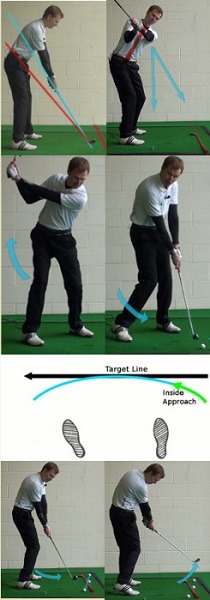
The Disadvantages of a Flat Golf Swing
There is nothing you can do in golf that is all upside and no downside. Every decision you make in your swing is a compromise, so you will always be gaining something through sacrificing something else. This is simply a fact of life on the golf course, so it is important that you think through both the pros and cons of any swing change before putting it to use.
You have already seen the list of positives above in reference to a flat golf swing – now it is time to look at the potential drawbacks. As was the case with the previous list, you might find that some of these points don't affect you at all, so keep an open mind if you should decide to head to the range to give a flat swing a try.
- Lack of backspin. Backspin, specifically as it relates to iron shots, is created when you hit down on the ball. By using a flat swing plane, you won't be hitting down on the ball as aggressively as a player who is using a steeper swing. With that said, you can still hit down on the ball with a flat swing, so it certainly is possible to generate a moderate amount of spin. However, if you play somewhere that frequently features hard greens which require high spin rates to stop the ball quickly, you may find that a steeper swing is needed to raise your spin rates.
- Difficulty from long grass. As your club comes into the ball when playing from a lie in the long grass, it will catch some of the blades of grass behind the ball before making contact. This 'interference' will slow the club head down and it could also twist the club head open or closed before you are able to strike the shot. When using a shallow (flat) angle of attack, you are likely to catch even more of the grass than you would with a steeper path. What that means is that you may struggle to play quality shots from the rough if you decide to use a flat swing. However, you could adjust for this by getting comfortable with the process of making a steeper swing when needed if you find your ball in deep grass. Basically, you would have two swing paths – one for your regular shots, and a steeper one to use when your ball is sitting down deep.
- Difficult transition to short shots. Most players will perform better on short shots when using a steeper plane. Things like pitch and chip shots are usually dealt with better by taking the club head down into the ball aggressively, and that is not the path that you will have built in to your game if you transition to a flatter move. While it is certainly possible to swing steeply on your short shots and flatter on your full swings, the transition between the two will take plenty of practice. Unless you are already a player with a strong and confident short game, this issue could be a problem.
- Flexibility required. The last drawback on our list isn't necessarily going to be a drawback for you, depending on your physical capabilities. If you are someone who has a high degree of flexibility in your lower back and your legs, there will be no problem making a great turn away from the ball. However, if flexibility is a problem for you, using a flat swing will be a challenge – and it may not work at all. You have to make a great shoulder turn in order to get the club back far enough to generate power. Players who can't make a big shoulder turn will likely want to stick with a steeper swing in order to create the space needed to hit the ball hard.
It is worth reiterating that not all of these points are going to apply for every golfer. Don't be discouraged by the number of potential drawbacks listed above – they are simply areas in which you may have trouble. It is very much possible to play golf well with a flat swing, so it is going to be up to you in the end to figure out if a flat swing plane is the best option for your game.

Bring Your Patience
If you currently use a steep golf swing, and you decide to switch to a flatter motion, expect to have plenty of hurdles and struggles along the way. There is nothing easy about changing your golf swing, as golf is one of the toughest games in the world. If it were easy to change your swing, everyone would do it – but it isn't. The only way to affect successful change is to commit to the process and be willing to ride out the tough spots along the way.
When getting started on the process of making this change, make sure you have a period of time set aside during which you can stay off of the course. Going out for a round quickly after trying to change your swing plane is one of the worst things you can do. Since you aren't yet going to be comfortable with the new swing after just a bucket or two of balls on the range, your body will revert back to your old swing almost immediately during a round. The best way to avoid that problem is to simply keep yourself out of that situation. Ideally, you will start the process of learning this new swing when you have at least a month or two where you can avoid playing golf while focusing on your new technique.
Another tip that will be useful in keeping your progress headed in the right direction on this swing change is to use short irons exclusively early on. Your short irons are the easiest clubs in the bag to hit, so it only makes sense to start there. You want to see as much success early on as possible, and that is going to happen by picking short clubs to use during these practice sessions. Stick with clubs like the pitching wedge and sand wedge while you are getting comfortable with the new swing, and only move up into longer clubs when you feel confident in your new mechanics.
As you progress with your adjusted mechanics, you are going to start to notice that you are producing a new ball flight. This flight is going to be quite an adjustment at first, so watch it closely on the range to learn your new tendencies. By picking specific targets for all of your range shots, you will learn what kind of aiming adjustments are going to be necessary in order to account for the new flight that you are producing.
There is a lot to like about using a flat swing. There are, also, some drawbacks. So should you use a flat swing in your game? Only you can make that decision. Think carefully about the status of your game and decide if the potential gains from a flatter plane are going to be work the effort. If so, use the information contained above to help you through the process of making the switch. Good luck!






